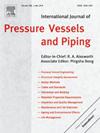Strain hardening effect on TES collapse moment of different angled pipe bends subjected to bending moments
IF 3.5
2区 工程技术
Q2 ENGINEERING, MECHANICAL
International Journal of Pressure Vessels and Piping
Pub Date : 2025-10-01
DOI:10.1016/j.ijpvp.2025.105673
引用次数: 0
Abstract
Piping systems carry fluid from one location to another and pipe bends are one of the most critical component due to its large deformation and high stress bearing nature. Collapse moment is one the criteria that helps to determine the strength of the pipe bend. The present study carries extensive three dimensional analyses to calculate the collapse moment of pipe bends (30° to 180° with interval of 30°) using twice-elastic-slope (TES) method. This paper focuses on the strain hardening (SH) effect on TES collapse moment based on elastic perfectly-plastic (EPP) material model for different bend angle and piping thickness under in-plane (closing (IPC) and opening (IPO)) and out-of-plane (OP) bending modes. From the results, it is clear that pipe thickness has significant role on hardening effect. Under IPC and OP bending modes, thicker pipe bend shows maximum hardening effect whereas under IPO mode least pipe thickness shows maximum hardening behavior due to its deformation pattern. Strain hardening effect changes maximum when bend angle changes from 30° to 60° for all bending modes. The hardening effect does not changes much for bend angle 60° to 180° under IPC and OP bending modes. Under IPO bending, hardening effect depends on bend angle for thinner pipe bends and for thicker pipe bends, it is independent of bend angle. This study helps to evaluate the bend angle hardening behavior influence on TES collapse moment which ultimately help determine the SH material model TES collapse moment based on the EPP material model.
弯矩作用下不同角度弯头TES崩塌弯矩的应变硬化效应
管道系统将流体从一个位置输送到另一个位置,由于其大变形和高应力承受特性,弯头是最关键的部件之一。坍塌力矩是确定弯管强度的标准之一。本研究采用双弹性斜率法(TES)对30°~ 180°、间隔为30°的弯道进行了广泛的三维分析计算。基于弹性完全塑性(EPP)材料模型,研究了面内(IPC)和面外(OP)弯曲模式下,不同弯曲角度和管道厚度下的应变硬化(SH)效应对TES坍塌力矩的影响。结果表明,管材厚度对硬化效果有显著影响。在IPC和OP弯曲模式下,较厚的弯管硬化效果最大,而在IPO模式下,最小的管厚由于其变形模式而表现出最大的硬化行为。在所有弯曲模式下,当弯曲角度从30°变化到60°时,应变硬化效果变化最大。在IPC和OP弯曲模式下,弯曲角度为60°~ 180°时,硬化效果变化不大。在IPO弯曲条件下,较细弯头的硬化效果与弯头角度有关,较粗弯头的硬化效果与弯头角度无关。本研究有助于评估弯角硬化行为对TES崩塌力矩的影响,最终确定基于EPP材料模型的SH材料模型TES崩塌力矩。
本文章由计算机程序翻译,如有差异,请以英文原文为准。
求助全文
约1分钟内获得全文
求助全文
来源期刊
CiteScore
5.30
自引率
13.30%
发文量
208
审稿时长
17 months
期刊介绍:
Pressure vessel engineering technology is of importance in many branches of industry. This journal publishes the latest research results and related information on all its associated aspects, with particular emphasis on the structural integrity assessment, maintenance and life extension of pressurised process engineering plants.
The anticipated coverage of the International Journal of Pressure Vessels and Piping ranges from simple mass-produced pressure vessels to large custom-built vessels and tanks. Pressure vessels technology is a developing field, and contributions on the following topics will therefore be welcome:
• Pressure vessel engineering
• Structural integrity assessment
• Design methods
• Codes and standards
• Fabrication and welding
• Materials properties requirements
• Inspection and quality management
• Maintenance and life extension
• Ageing and environmental effects
• Life management
Of particular importance are papers covering aspects of significant practical application which could lead to major improvements in economy, reliability and useful life. While most accepted papers represent the results of original applied research, critical reviews of topical interest by world-leading experts will also appear from time to time.
International Journal of Pressure Vessels and Piping is indispensable reading for engineering professionals involved in the energy, petrochemicals, process plant, transport, aerospace and related industries; for manufacturers of pressure vessels and ancillary equipment; and for academics pursuing research in these areas.

 求助内容:
求助内容: 应助结果提醒方式:
应助结果提醒方式:


